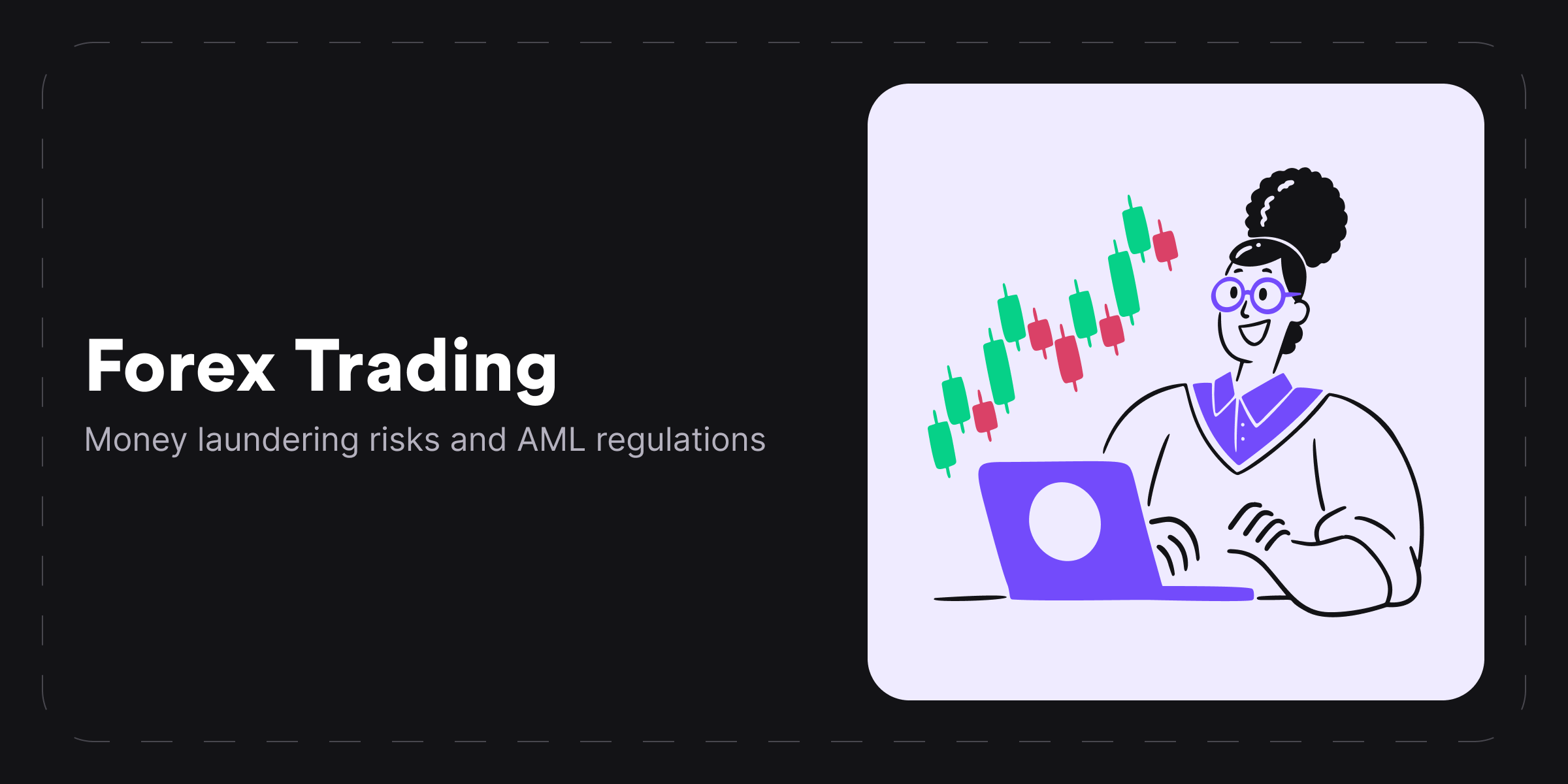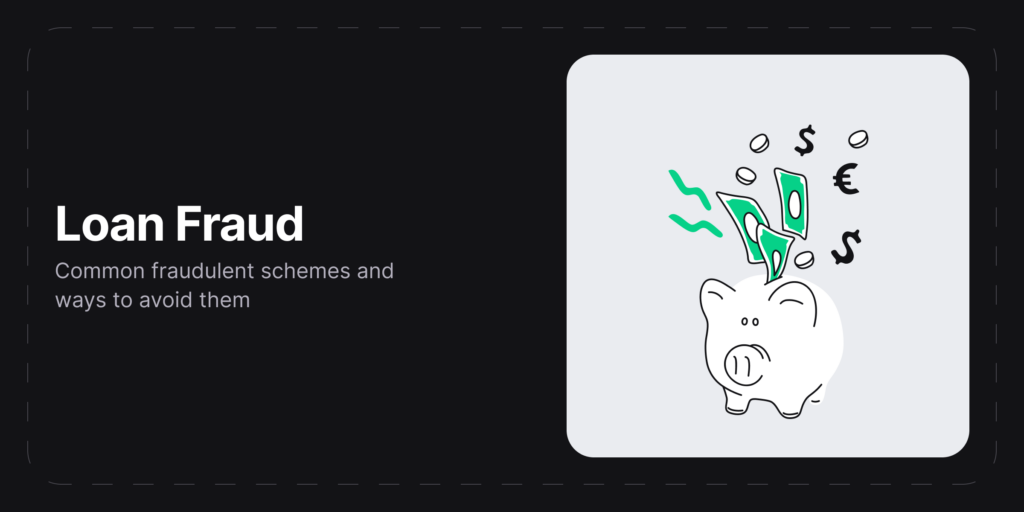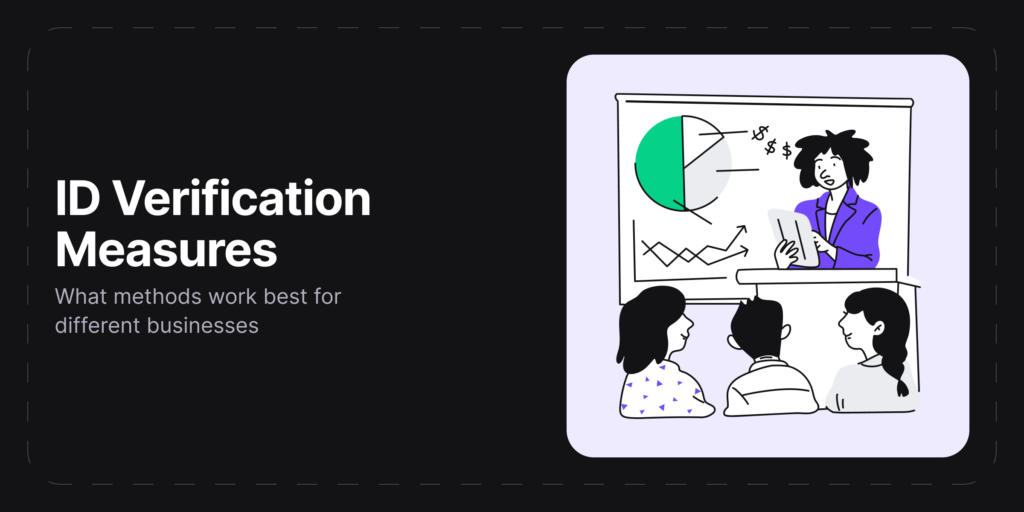Foreign exchange (FX), or forex trading, is one of the biggest financial markets in the world right now, still winning the race against other spheres like decentralized cryptocurrencies or stocks.
According to the New York Stock Exchange the forex market has an impressive trading volume, which is about $200 billion daily on average. Due to this level of demand, the forex market is open 24/7; however, a large portion of the trade comes from billionaire traders or well-established hedge funds rather than standard retail traders.
So, even though the FX market has welcomed many of its traders with open arms, the door was opened for all sorts of individuals with bad intentions. Money launderers use various FX businesses to use weaknesses in the system for their advantage, both in the commercial and the banking sectors. In general, diverse entities provide FX services, including brokers, investment firms, or simple money transfer companies.
That said, if you’re operating in the forex trading landscape or have any ties with FX businesses, you should consider learning about specific money laundering risks that this sector creates. In this blog post, we’ll explore Anti-Money Laundering (AML) risks and complex use cases when criminals use this exploitable marketplace for their own “good”.
What is Forex (FX) Trading?
Forex (foreign) trading is the process of exchanging different international currencies in a global market, which involves simultaneously selling and buying currencies for trillions of dollars daily. Despite lacking a centralized physical location, the forex market is the world’s largest and most liquid financial market. Its convenience makes it highly favored by a variety of traders, including banks and fund managers.
Forex trading operates as an over-the-counter (OTC) market. That is why there is no centralized exchange control. Often, currencies are traded electronically through a network. Financial players, such as corporate company merchants, also trade in this market. When someone purchases from a foreign country, they make the payment in the currency of that country. That’s why traders study exchange rates that show how another currency will restore one currency and invest in currencies they think will become more profitable in the future.
How Forex Trading Actually Works
Forex trading revolves around speculation, similar to how people sell and buy stocks. There’s an interbank market where both commercial and investment banks operate. While forex traders aim to buy currencies at a low price and sell them at a higher price to make a profit, big players like JPMorgan Chase & Co. also act as market makers and have influence over the exchange rates.
However, unlike stock traders who deal with shares, forex traders trade currencies. An investor can benefit from forex trading by capitalizing on fluctuations in currency values. That means they can profit when the base currency increases or decreases in value. For example, when the US imports agricultural products from foreign countries like India, payments are typically made in the exporting country’s reserve currency, and in this case, Indian Rupee.
Why the Forex Market is So Convenient
Believe it or not, concepts similar to those of forex markets were found as early as the late 1800s. So, unlike some cryptocurrencies, which, even though they have now become mainstream, forex markets aren’t just a trend. The biggest benefit for forex traders who know the market and can respond to fluctuations promptly is the profit.
What else? We list some key aspects of the convenience that the forex market provides below:
- 24-hour market. Forex operates five days a week, 24 hours a day, with some exceptions on public holidays.
- Liquidity and size. The market is huge, providing opportunities for everyone on a global scale.
- High returns. Like many volatile markets, forex trading can result in substantial wins when done right, but there’s also a risk of rapid loss.
- Leverage. Traders can control large positions with relatively small amounts of capital. This increases their chances for potential profits.
Why is Money Laundering an Issue for Forex Trading?
Global forex markets determine exchange rates through the supply and demand of various currencies. But, as we know, forex trading is challenging because it’s volatile, and from a regulatory perspective, this makes it harder to regulate the industry by implementing AML measures. Factors like war, inflation and other interest rates influence forex market forces.
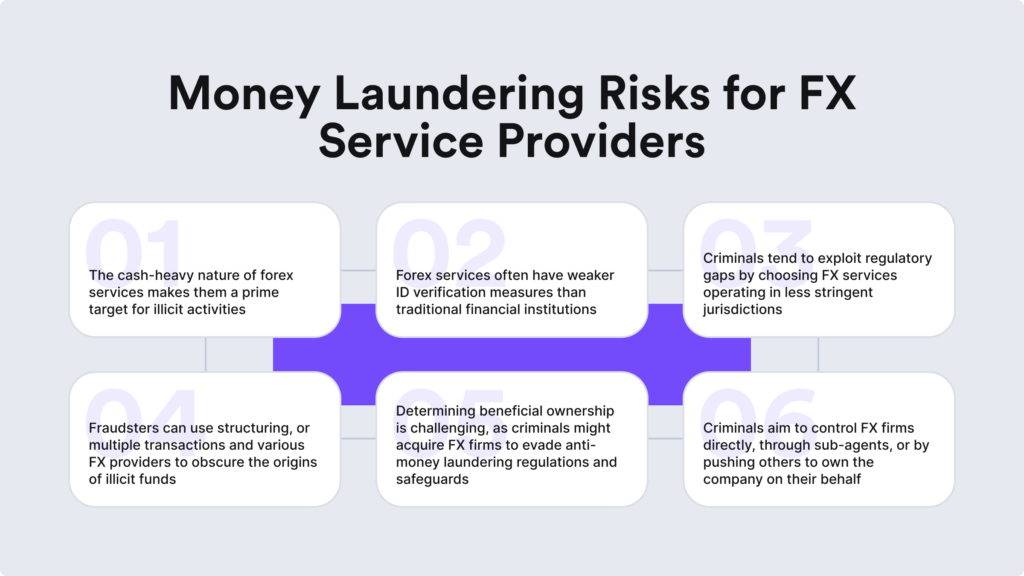
That means geopolitical events can have unpredictable outcomes and almost always devalue a country’s currency. So, in times of uncertainty, investors often go for their safe picks, such as the US dollar, because it is considered a stable currency.
However, the complexity doesn’t end here. Other reasons why FX trading is attractive for money laundering include:
- A high volume of cross-border transactions. The nature of remittances creates an attractive space for criminals to use money mules and transfer funds on their behalf.
- Zero or not enough KYC/AML controls. Forex firms don’t have the same security requirements as traditional financial institutions. This includes measures like mandatory identity verification for all clients opening new accounts.
- More and more FX trading service providers. The increasing number of forex platforms makes it harder for authorities to effectively track, detect and monitor red flags, cases of fraud, and other instances of financial crime.
In other words, the forex market is not properly monitored due to its decentralized nature. At the same time, using at least some sort of anonymity, fraudsters can avoid detection and launder illicit funds. So, given such vulnerabilities, companies should make AML compliance their priority.
How is the FX Market Actually Regulated?
There are multiple different regulatory compliance requirements in the FX market. Since forex trading is a service that’s happening all over the world, there isn’t a unified approach that applies to all FX platforms and all jurisdictions. Like many financial institutions, forex trading firms apply a risk-based approach to AML compliance, which is based on the FATF’s guidance for the Securities sector.
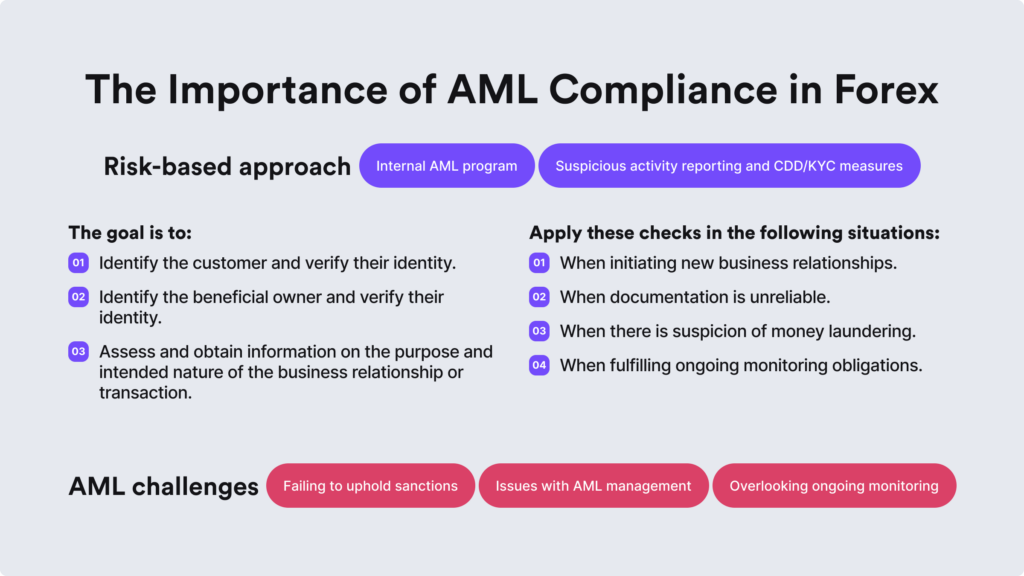
Most jurisdictions, depending on where the forex platform operates, require having an AML program. It consists of several steps, such as setting up internal AML controls and policies, gathering data, conducting independent audits, or training staff. Other key prominent compliance measures include robust customer due diligence (CDD) practices and suspicious activity detection and reporting to relative authorities.
Money Laundering Risks According to the FATF
The FATF, or the Financial Action Task Force, is a global watchdog that implements new policies and recommendations for countries around the world to cope with AML risks better. Similar to the mentioned factors, such as the increased number of FX providers or the whole market’s increasing accessibility level, there are other risks associated with the FX trading sector.
Some key vulnerabilities in terms of money laundering include:
Differences in AML/CTF Regulations
The FATF has found that many high-risk countries lack sufficient AML regulations to address the AML challenges that come with inconsistencies or gaps in regulatory standards. The cross-border nature of the FX market doesn’t help in this sense, either. As a result, FX platforms lack a unified approach to how they report suspicious activity to authorities or lack proper cross-border communication among other financial authorities when doing AML investigations.
A High Level of Anonymity
Despite regulatory requirements, foreign exchange platforms provide some sort of anonymity shield that’s not typically found in other financial institutions. For example, some investors can trade on a national market specifically using more secretive pools. Despite that, even anonymous FX brokerage firms are regulated. That means they can’t provide complete anonymity and must stick to proper due diligence measures intended to verify identities or at least allow authorities to access such data if needed.
A Secrecy Around Beneficial Ownership
Criminals use FX platforms to launder money by simply acquiring such businesses and then using them to bypass AML regulations. Fraudsters also indirectly control forex firms through sub-agents or proxies. They also conceal the true ownership structure and use another person to launder money on their behalf. This form of manipulation makes it difficult to detect the laundered funds since criminals are skilled at finding ways to bypass AML laws.
A Higher Risk of Structuring
Once again, the inconsistency in AML regulations across countries makes forex trading a good space for structuring. It’s a common practice for criminals to launder funds by taking the money and putting it into smaller transactions below the reporting threshold. In other words, criminals use a series of transactions to conceal the origins of their dirty money before putting it into the legitimate financial system
Forex transactions are at risk because criminals can transfer their illegal funds through various FX service providers in multiple currencies, further obscuring their origins and assimilating them into legitimate financial channels. After circulating through legitimate financial channels multiple times, the laundered funds eventually return to the originators
Related: Smurfing in Money Laundering Explained
The Impact of AML Rules on Forex Trading
Each country is responsible for managing its currency. Based on the same principles, forex trading happens globally, yet each country is responsible for sticking to its own AML rules. But. There’s a “but”. A single regulatory change in one country’s forex trading environment can push changes in other countries to maintain stability in the whole FX market.
When all forex platforms adhere to these standards, the market functions more transparently, enabling investors to make decisions based on stable market conditions, which builds confidence and trust. If forex businesses fail to comply with these regulations and are involved in money laundering or terrorist financing, they can face legal action.
How to Detect Money Laundering in Forex Trading?
In line with FATF recommendations to maintain AML compliance and detect money laundering, forex trading service providers should adopt robust Customer Due Diligence (CDD) processes.
This includes processes that verify customer identities. What’s more, FX firms should have AML screening and transaction monitoring measures in place. These AML processes are particularly beneficial for detecting high-risk customers and transactions, particularly those known for their red flag-like behaviors.
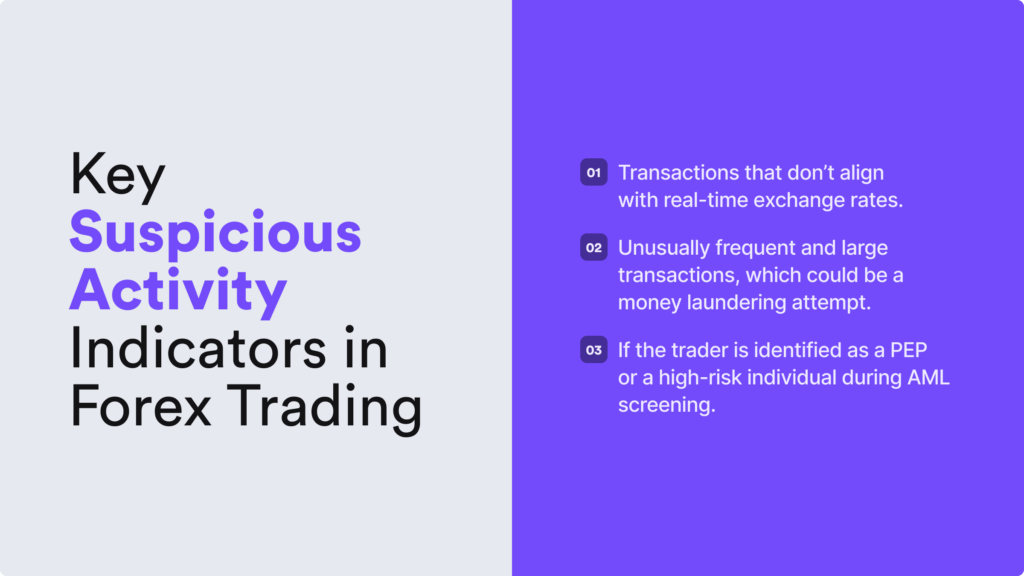
To identify money laundering and other forms of forex trading fraud, you should also:
- Be extra vigilant when assessing the level of risk linked to FX traders. KYC and AML checks are here for a reason. People like politically exposed persons (PEPs) are considered high-risk and sometimes may require Enhanced Due Diligence (EDD) measures.
- Have a good general understanding of the foreign exchange market, such as real-time knowledge of international currency values (this helps detect suspicious transactions that don’t align with proper currency exchange rates).
Related: What is an AML Compliance Program?
Forex Trading Red Flags that Show Signs of Money Laundering
There are some well-known indicators that are potential signs of money laundering. In forex trading, the principles are the same. For example, structured transactions involving multiple transfers across different countries or payments made to high-risk jurisdictions are also red flags linked to illicit activities.
However, there are also other behaviors that serve as red flags indicating potential money laundering in the FX trading sphere. For example:
- Multiple transactions just above the reporting threshold.
- Several transactions that were made in different currencies.
- High volumes or large volumes of transactions that could indicate suspicious patterns.
- Multiple exchanges across different forex trading service providers.
- Clients who send out mules on their behalf or who are hesitant to provide their personal data.
- Customers that provide fake or altered identity data during KYC checks.
- Customers that show up during adverse media screening, are on sanctions lists, or have a PEP status.
- Transactions with PEPs, sanctioned individuals, or customers featured in adverse media.
- Clients who hide their identities and have others (money mules) make transactions for them.
- Customers who are currently under investigation by law enforcement or have been investigated in the past.
How iDenfy’s AML Solutions Can Help the Forex Trading Industry
With different regional compliance regulations and the burden that comes with AML rules, at iDenfy, we absolutely know how important it is to switch from a manual workflow to a strategy that’s backed by data and automation. Inadequate KYC/AML processes put FX firms at serious legal risks or, sometimes worse, lost customers and reputational damage. We don’t want that.
Our complete RegTech platform is one of the only AML packages (with features like identity verification, business verification, AML screening and ongoing monitoring, transaction monitoring, risk assessment, and, believe it or not, the list goes on) that today’s market has to offer.
So, with our AML software, you can protect your FX platform and collect, analyze and monitor large amounts of data in real-time, onboarding genuine traders and flagging suspicious users through a simple, easy-to-use dashboard that doesn’t confuse internal compliance officers.
Let’s talk about a more personalized and in-depth approach to your particular case.
